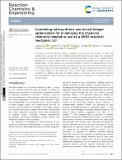| dc.contributor.author | Gao, Hanyu | |
| dc.contributor.author | Coley, Connor Wilson | |
| dc.contributor.author | Struble, Thomas J | |
| dc.contributor.author | Li, Linyan | |
| dc.contributor.author | Qian, Yujie | |
| dc.contributor.author | Green Jr, William H | |
| dc.contributor.author | Jensen, Klavs F | |
| dc.date.accessioned | 2020-02-13T15:37:39Z | |
| dc.date.available | 2020-02-13T15:37:39Z | |
| dc.date.issued | 2020-01 | |
| dc.date.submitted | 2019-08 | |
| dc.identifier.issn | 2058-9883 | |
| dc.identifier.uri | https://hdl.handle.net/1721.1/123797 | |
| dc.description.abstract | The access to essential medicines remains a problem in many low-income countries for logistic and expiration limits, among other factors. Enabling flexible replenishment and easier supply chain management by on demand manufacturing from stored starting materials provides a solution to this challenge. Recent developments in computer-aided chemical synthesis planning have benefited from machine learning in different aspects. In this manuscript, we use those techniques to perform a combined analysis of a WHO essential medicines list to identify synthetic routes that minimize chemical inventory that would be required to synthesize the all the active pharmaceutical ingredients. We use a synthesis planning tool to perform retrosynthetic analyses for 99 targets and solve a mixed-integer programming problem to select a combination of pathways that uses the minimal number of chemicals. This work demonstrates the technical feasibility of reducing storage of active pharmaceutical ingredients to a minimal inventory of starting materials. | en_US |
| dc.description.sponsorship | United States. Army Research Office (Contract W911NF-16-2-0023) | en_US |
| dc.publisher | Royal Society of Chemistry (RSC) | en_US |
| dc.relation.isversionof | http://dx.doi.org/10.1039/c9re00348g | en_US |
| dc.rights | Creative Commons Attribution 3.0 unported license | en_US |
| dc.rights.uri | https://creativecommons.org/licenses/by/3.0/ | en_US |
| dc.source | Royal Society of Chemistry (RSC) | en_US |
| dc.title | Combining retrosynthesis and mixed-integer optimization for minimizing the chemical inventory needed to realize a WHO essential medicines list | en_US |
| dc.type | Article | en_US |
| dc.identifier.citation | Gao, Hanyo et al. "Combining retrosynthesis and mixed-integer optimization for minimizing the chemical inventory needed to realize a WHO essential medicines list." Reaction Chemistry & Engineering 5, 2 (January 2020): 367-376 © 2020 Royal Society of Chemistry | en_US |
| dc.contributor.department | Massachusetts Institute of Technology. Department of Chemical Engineering | en_US |
| dc.contributor.department | Massachusetts Institute of Technology. Computer Science and Artificial Intelligence Laboratory | en_US |
| dc.relation.journal | Reaction Chemistry & Engineering | en_US |
| dc.eprint.version | Final published version | en_US |
| dc.type.uri | http://purl.org/eprint/type/JournalArticle | en_US |
| eprint.status | http://purl.org/eprint/status/PeerReviewed | en_US |
| dspace.date.submission | 2020-02-11T16:55:47Z | |
| mit.journal.volume | 5 | en_US |
| mit.journal.issue | 2 | en_US |
| mit.license | PUBLISHER_CC | |
| mit.metadata.status | Complete | |
